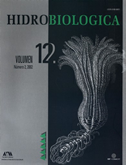Metabolic responses to natural and artificial feeding on the Caribbean Spiny Lobter juveniles, Panulirus argus (Latreille, 1804)
Keywords:
Metabolic response, Panulirus argus, man-made foodAbstract
With the objective of evaluating the metabolic response and the calorigenic effect of the natural and artificial feeding in spiny lobster Panulirus argus juveniles, experiments were made in a dynamic respirometer where cameras worked as aquatic metabolic cages, allowing the determination of the oxygen consumption and the ammonia excretion during the fast and the feeding. The bioenergetics index was calculated, apparent heat increment (AHI), postpandrial nitrogen excretion (PPNE) and the atomic ration O:N. The studied foods were the mollusks, Lima scabra, chiton Acanthopleura granullata, and sea snail Littorina mespillum; the black sea urchin Echinometra lucunter, the crab Plagussia depressa; and two isocaloric foods that contain 25 and 45 protein%. To the artificial foods, the chiton and the sea urchin a bromathologic analysis was carried out. During the 6 hours of experimentation, for the chiton A. granullata, the VO2/W increased to 2.4 times the value of the fast, which represents 2454 joules kg-1bh.h-1, while the U/W took a value 2.9 times higher, equivalent to 632 joules kg-1bh.h-1. The ratio O:N diminished at 12.9, indicating the catabolism of proteins. Results are compared with the following observation not in all the cases, the proteins are used as an energy substrate, mainly in those species in which the lipids are well represented. Elements are analyzed in order to confirm the strict carnivory of this species.Downloads
Downloads
How to Cite
Issue
Section
License
Los autores/as que publiquen en esta revista aceptan las siguientes condiciones:
De acuerdo con la legislación de derechos de autor, HIDROBIOLÓGICA reconoce y respeta el derecho moral de los autores, así como la titularidad del derecho patrimonial, el cual será cedido a la revista para su difusión en acceso abierto.
Publicar en la revista HIDROBIOLÓGICA tiene un costo de recuperación de $500 pesos mexicanos por página en blanco y negro (aproximadamente 29 dólares americanos) y $1000 pesos por página a color (aproximadamente 58 dólares americanos).
Todos los textos publicados por HIDROBIOLÓGICA sin excepción se distribuyen amparados bajo la licencia Creative Commons 4.0Atribución-No Comercial (CC BY-NC 4.0 Internacional), que permite a terceros utilizar lo publicado siempre que mencionen la autoría del trabajo y a la primera publicación en esta revista.
Los autores/as pueden realizar otros acuerdos contractuales independientes y adicionales para la distribución no exclusiva de la versión del artículo publicado en HIDROBIOLÓGICA (por ejemplo incluirlo en un repositorio institucional o publicarlo en un libro) siempre que indiquen claramente que el trabajo se publicó por primera vez en HIDROBIOLÓGICA.
Para todo lo anterior, el o los autor(es) deben remitir el formato de Carta-Cesión de la Propiedad de los Derechos de la primera publicación debidamente requisitado y firmado por el autor(es). Este formato se puede enviar por correo electrónico en archivo pdf al correo: enlacerebvistahidrobiológica@gmail.com; rehb@xanum.uam.mx (Carta-Cesión de Propiedad de Derechos de Autor).
Esta obra está bajo una licencia de Creative Commons Reconocimiento-No Comercial 4.0 Internacional.


